Explosive Trends in the Mortar Ammunition Market: Key Developments and Insights
The mortar ammunition market is experiencing significant transformations driven by technological advancements, geopolitical dynamics, and evolving military strategies. Understanding the latest developments in this sector is crucial for stakeholders, including military organizations, defense contractors, and policymakers. In this article, we will explore the most critical trends shaping the mortar ammunition market today, shedding light on innovations, market dynamics, and future projections.
Overview of the Mortar Ammunition Market
Mortar ammunition plays a vital role in modern warfare, providing indirect fire support for ground troops. These weapons systems, typically launched from a portable tube, deliver explosive projectiles to a designated target area. Mortars are valued for their versatility, ease of use, and effectiveness in both offensive and defensive operations.
Current Market Landscape
As of 2024, the global mortar ammunition market is estimated to be valued at approximately $X billion, with projections indicating a compound annual growth rate (CAGR) of Y% over the next five years. The market is driven by several factors, including rising defense budgets, increased military modernization efforts, and the growing need for effective counterinsurgency strategies.
Key Players in the Market
Several companies dominate the mortar ammunition sector, including:
- Northrop Grumman
- General Dynamics
- BAE Systems
- Rheinmetall
- Thales Group
These players are investing heavily in research and development (R&D) to enhance their product offerings, focusing on precision, reliability, and lethality.
Technological Innovations Shaping the Market
The mortar ammunition market is witnessing a wave of technological advancements that are revolutionizing the capabilities of these weapons systems. Here are some of the most notable innovations:
1. Smart Mortars
Smart mortar technology, equipped with advanced guidance systems, has emerged as a game-changer in the industry. These projectiles use GPS and inertial navigation systems to improve accuracy, reducing collateral damage and increasing operational effectiveness. For example, the development of the “Smart 120mm mortar round” has demonstrated precision strikes that can hit targets within meters.
2. Enhanced Propulsion Systems
Innovations in propulsion systems have resulted in increased range and velocity for mortar projectiles. New designs are allowing mortars to fire at longer distances without sacrificing accuracy. This development enhances the strategic positioning of troops, allowing them to remain out of harm’s way while still delivering effective fire support.
3. Modular Ammunition Design
Modular designs in mortar ammunition enable military forces to customize their ordnance based on mission requirements. This flexibility allows for the integration of various payloads, including high-explosive, smoke, and illumination rounds, catering to diverse operational scenarios.
4. Improved Materials
Advancements in materials science have led to the creation of lighter, more durable mortar rounds. The use of composite materials not only reduces the overall weight of ammunition but also enhances its resilience to extreme environmental conditions, ensuring reliability in the field.
Geopolitical Influences and Market Dynamics
The geopolitical landscape significantly influences the mortar ammunition market. As global tensions rise, nations are compelled to modernize their military capabilities, leading to increased investments in defense sectors. Here are some key geopolitical trends affecting the market:
1. Increased Defense Budgets
Countries worldwide are ramping up their defense spending in response to regional threats. For instance, NATO member states have pledged to increase their defense budgets to meet the alliance’s target of 2% of GDP. This commitment directly benefits the mortar ammunition market, as governments seek to bolster their artillery capabilities.
2. Regional Conflicts and Insurgency
Ongoing conflicts in regions such as the Middle East and Eastern Europe have intensified the demand for effective artillery support, including mortar systems. Military operations against insurgent groups require precise and rapid-fire capabilities, further driving the market’s growth.
3. Focus on Asymmetric Warfare
Asymmetric warfare strategies, where non-state actors employ unconventional tactics, necessitate the development of advanced mortar systems. Military forces are increasingly seeking lightweight, mobile mortars that can be rapidly deployed in urban environments.
Challenges Facing the Mortar Ammunition Market
Despite the positive outlook for the mortar ammunition market, several challenges persist that could impact its growth trajectory:
1. Regulatory Hurdles
The defense industry is heavily regulated, and compliance with international arms treaties and regulations can pose challenges for manufacturers. Export restrictions and varying national regulations can complicate market access for new products.
2. Supply Chain Disruptions
Recent global events, including the COVID-19 pandemic, have exposed vulnerabilities in supply chains. Manufacturers face challenges in sourcing raw materials and components, leading to potential delays in production and delivery.
3. Competition from Alternative Technologies
As military forces explore new technologies, such as drones and guided missiles, traditional mortar systems may face increased competition. Manufacturers must innovate continuously to ensure mortar ammunition remains a viable option in modern warfare.
Future Outlook: Trends to Watch
The mortar ammunition market is set to evolve significantly in the coming years. Here are some trends to monitor:
1. Greater Emphasis on Cybersecurity
With the integration of smart technologies into mortar systems, cybersecurity will become paramount. Protecting the integrity of guidance systems and communication networks will be critical to ensuring operational effectiveness.
2. Rising Interest in Joint Operations
As military forces engage in joint operations with allied nations, the demand for standardized ammunition will grow. This trend will drive collaboration among manufacturers to produce compatible mortar systems that can be used interchangeably.
3. Sustainable Manufacturing Practices
Environmental concerns are leading to a greater focus on sustainability in defense manufacturing. Companies are increasingly adopting eco-friendly practices, such as reducing waste and utilizing sustainable materials in ammunition production.










